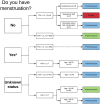Circulating sex-steroids and Staphylococcus aureus nasal carriage in a general female population
- PMID: 33428587
- PMCID: PMC7849480
- DOI: 10.1530/EJE-20-0877
Circulating sex-steroids and Staphylococcus aureus nasal carriage in a general female population
Erratum in
-
Circulating sex-steroids and Staphylococcus aureus nasal carriage in a general female population.Eur J Endocrinol. 2021 May 13;184(6):X3. doi: 10.1530/EJE-20-0877e. Eur J Endocrinol. 2021. PMID: 33984833 Free PMC article. No abstract available.
Abstract
Objective: Staphylococcus aureus is a major human pathogen, and nasal carriers have an increased risk for infection and disease. The exploration of host determinants for nasal carriage is relevant to decrease infection burden. Former studies demonstrate lower carriage prevalence in women and among users of progestin-only contraceptives. The aim of this study was to investigate the possible associations between circulating sex-steroid hormones and nasal carriage of Staphylococcus aureus in a general population.
Methods: In the population-based sixth Tromsø study (2007-2008) nurses collected nasal swab samples from 724 women aged 30-87 not using any exogenous hormones, and 700 of the women had a repeated nasal swab taken (median interval 28 days). We analysed a panel of serum sex-steroids by liquid chromatography tandem mass spectrometry, and collected information about lifestyle, health and anthropometric measures. Multivariable logistic regression was used to study the association between circulating sex-steroids and Staphylococcus aureus carriage (one swab) and persistent carriage (two swabs), while adjusting for potential confounding factors. Women in luteal phase were excluded in the analysis of androgens.
Results: Staphylococcus aureus persistent nasal carriage prevalence was 22%. One standard deviation increase in testosterone and bioavailable testosterone was associated with lower odds of persistent nasal carriage, (OR = 0.57; 95% CI = 0.35-0.92 and OR = 0.52, 95% CI = 0.30-0.92) respectively. Analysis stratified by menopause gave similar findings. Persistent carriers had lower average levels of androstenedione and DHEA, however, not statistically significant.
Conclusion: This large population-based study supports that women with lower levels of circulating testosterone may have increased probability of Staphylococcus aureus persistent carriage.
Figures



Similar articles
-
Circulating sex-steroids and Staphylococcus aureus nasal carriage in a general male population.Epidemiol Infect. 2022 Apr 22;150:e93. doi: 10.1017/S0950268822000735. Epidemiol Infect. 2022. PMID: 35543107 Free PMC article.
-
Hormonal contraceptive use and persistent Staphylococcus aureus nasal carriage.Clin Infect Dis. 2012 Dec;55(12):1625-32. doi: 10.1093/cid/cis778. Epub 2012 Sep 5. Clin Infect Dis. 2012. PMID: 22955426
-
Hormonal contraceptive use and Staphylococcus aureus nasal and throat carriage in a Norwegian youth population.PLoS One. 2019 Jul 5;14(7):e0218511. doi: 10.1371/journal.pone.0218511. eCollection 2019. PLoS One. 2019. PMID: 31276521 Free PMC article. Clinical Trial.
-
Nasal carriage of meticillin resistant Staphylococcus aureus: the prevalence, patients at risk and the effect of elimination on outcomes among outclinic haemodialysis patients.Eur J Med Res. 2007 Jul 26;12(7):284-8. Eur J Med Res. 2007. PMID: 17933699 Clinical Trial.
-
Intestinal carriage of Staphylococcus aureus: how does its frequency compare with that of nasal carriage and what is its clinical impact?Eur J Clin Microbiol Infect Dis. 2009 Feb;28(2):115-27. doi: 10.1007/s10096-008-0602-7. Epub 2008 Aug 8. Eur J Clin Microbiol Infect Dis. 2009. PMID: 18688664 Review.
Cited by
-
Staphylococcus aureus nasal carriage and bloodstream infection among conventional hemodialysis patients in Thailand: a prospective multicenter cohort study.BMC Res Notes. 2022 Sep 6;15(1):290. doi: 10.1186/s13104-022-06185-y. BMC Res Notes. 2022. PMID: 36068640 Free PMC article.
-
Nasal carriage rate and multiple antimicrobial resistance indices of Staphylococcus aureus among healthcare students at the Ahmadu Bello University, Nigeria.Afr J Lab Med. 2025 Jun 27;14(1):2667. doi: 10.4102/ajlm.v14i1.2667. eCollection 2025. Afr J Lab Med. 2025. PMID: 40612402 Free PMC article.
-
Circulating sex-steroids and Staphylococcus aureus nasal carriage in a general male population.Epidemiol Infect. 2022 Apr 22;150:e93. doi: 10.1017/S0950268822000735. Epidemiol Infect. 2022. PMID: 35543107 Free PMC article.
References
-
- NORM/NORM-VET. Usage of Antimicrobial Agents and Occurrence of Antimicrobial Resistance in Norway, 2015. Available from: https://www.vetinst.no/en/surveillance-programmes/norm-norm-vet-report
-
- Olsen K, Falch BM, Danielsen K, Johannessen M, Ericson Sollid JU, Thune I, Grimnes G, Jorde R, Simonsen GS, Furberg AS.Staphylococcus aureus nasal carriage is associated with serum 25-hydroxyvitamin D levels, gender and smoking status. The Tromso Staph and Skin Study. European Journal of Clinical Microbiology and Infectious Diseases 2012. 31 465–4. (10.1007/s10096-011-1331-x) - DOI - PMC - PubMed
MeSH terms
Substances
LinkOut - more resources
Full Text Sources
Other Literature Sources

